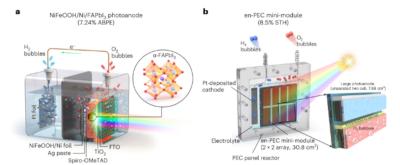Researchers at Ulsan National Institute of Science and Technology (UNIST) recently set out to develop a scalable photoelectrochemical (PEC) system to produce green hydrogen.
(a) Concept design of NiFeOOH/Ni/FAPbI3 photoanode-based water splitting cell. (b) All-PSK-based encapsulated PEC reactor made of repeated mini-modules. Credit: Nature Energy & Dr Dharmesh Hansora, UNIST
The team explained that for practical photoelectrochemical water splitting to become a reality, highly efficient, stable and scalable photoelectrodes are essential. However, meeting these requirements simultaneously is a difficult task, as improvements in one area can often lead to deterioration in others. To address this challenge, the team developed a formamidinium lead triiodide (FAPbI3) perovskite-based photoanode that is encapsulated by an Ni foil/NiFeOOH electrocatalyst, which demonstrates promising efficiency, stability and scalability.
This metal-encapsulated FAPbI3 photoanode records a photocurrent density of 22.8 mA cm−2 at 1.23 VRHE (where VRHE is voltage with respect to the reversible hydrogen electrode) and shows excellent stability for 3 days under simulated 1-sun illumination.
The scientists also constructed an all-perovskite-based unassisted photoelectrochemical water splitting system by connecting the photoanode with a same-size FAPbI3 solar cell in parallel, which records a solar-to-hydrogen efficiency of 9.8%.
Finally, they demonstrated the scale-up of these Ni-encapsulated FAPbI3 photoanodes into mini-modules up to 123 cm2 in size, recording a solar-to-hydrogen efficiency of 8.5%.
The team explained that unlike other PV grade materials, metal-halide perovskites (MHP) have unique characteristics of high efficiency but low cost, and could become an alternative photoelectrode material if their stability issue is properly addressed. MHP materials have excellent optoelectronic properties and tunable band-gaps, which are desired to provide necessary photocurrent and photovoltage to split water and produce oxygen and hydrogen in a single PEC cell. However, the challenge of stability in humid conditions and under UV light needs to be addressed before real use can take place.
The researchers tried to stabilize the MHP material using metal-encapsulation or metal-protection to prepare photoelectrodes for the PEC cell. Another challenge for practical application is scalability – to maintain the high efficiency of laboratory cell (< 1 cm2 ) at practical large scale (1 m2 ). In their study, the team selected the most advanced MHP material in efficiency and stability (FAPbI3) and encapsulated it with a thick nickel foil (30 um) deposited with an NiFeOOH catalyst to protect the MHP from water and promote oxygen evolution reaction for water splitting.
With the lab-scale device, the team achieved 9.89% STH efficiency with long term stability. Then, they up-scaled the small-area device to practical large area PEC system by using a module-based design – by selecting a 7.68 cm2 device as the basic mini-module and repeating it horizontally and vertically to fabricate a large-size device.
During such an upscaling process, there was a minimum loss of efficiency and long-term stability was demonstrated as well, which represents an excellent outcome.
The resulting all-perovskite PEC system was composed of a FAPbI3 photoanode, which is MHP thin-films protected using Nickel metal foil as encapsulation and NiFeOOH as catalyst layer on it. This photoanode was optimized using different metal foils and the in-depth catalyst-electrolyte interactions were studied. Small area FAPbI3 photoanodes (0.25 cm2 ) were tested using photoanode connected to solar cell (PEC-PV) in a single reactor system.
The scientists reported 9.89% (close to 10%) efficiency using small-area devices.
To minimize the system's complexity, the team integrated both components in single PEC device to avoid extra use of PV component, which is a unique advantage that can reduce the cost of the system.
Looking ahead, the team plans to achieve further improvements in efficiency and stability of the PEC system by integrating photoelectrodes, e.g., photoanodes-photocathodes together and selecting more efficient and durable catalysts.




